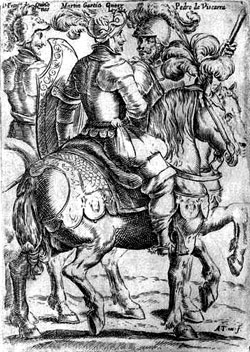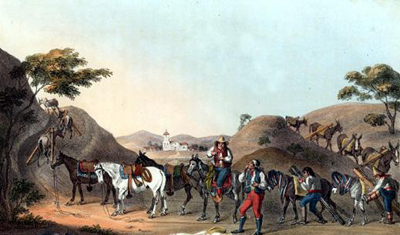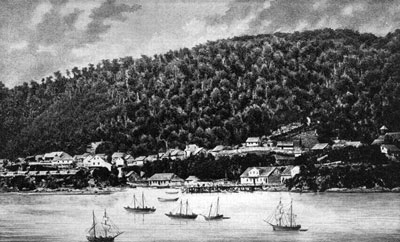|
The
first Irish people to travel to Chile were 'Guillermo' and
'Juan' from Galway, who arrived with Magellan's expedition,
and discovered the strait that bears his name in 1520. The
first Irishman to start a family in Chile was John Evans who
bore the title of Captain. In 1737, he settled in the region
of Chillán and married Manuela de Vizcarra, a lady who
according to family lore was related to Pedro de Vizcarra, who
had been Governor of the Kingdom. Evans dedicated himself to
trade and cattle-breeding. He made a fortune and bought a
house and land, and later, in 1754, a large estate between
Longavi and Perquilauquén, close to where Parral is today. He
was also the owner of some mountain land, known as the 'Cajón
de los Ibañez,' (Evans' Chest) where there were thermal
waters.
|

Francisco de Quiñones,
Martín García Óñez de Loyola y Pedro de Vizcarra, in:
Histórica relación del Reyno de Chile by Alonso de
Ovalle (1646)
(Colección
Biblioteca Nacional) |
The
chillanejo locals did not understand the name 'Evans,' or 'Ivans' as
Don Juan would have perhaps pronounced it, and quickly
hispanicised the surname to 'Ibáñez.' Roa y Ursúa recorded
eight children from the Ibáñez Vizcarra marriage (Gonzalo
Vial 11), whose descendants constituted, one hundred years
later, according to Vicuña Mackenna, 'a vigorous and numerous
tribe' that 'conserved the characteristics of its founder.' In
the following century, the son of the great-grandson of John
Evans, Carlos Ibáñez, was twice president of the Republic of
Chile, 1927-1931 and 1952-1958.
The
second Irishman to arrive in Chile was John Garland, a cavalry
officer in the Military Order of Santiago, who had been a
cadet in the Hibernia Regiment in Spain. In Chile, as Planning
Engineer, he was the boss of his countryman Ambrose O'Higgins,
with whom he shared his plans for the moving of Concepción to
the place where it is currently situated, far from the dangers
of the rivers and the sea. In 1764, Garland was named Military
Governor of Valdivia and later Director of Fortifications. He
died on a trip to Europe.
Another
Irishman who arrived in Chile in those days was John Clarke,
among whose descendants was the engineer of that surname who
was involved in the construction of the trans-Andean railway.
Thomas O'Fallon also arrived during this time, travelling from
Ireland to Spain and thence to Chile. In Castro, he married a
woman with the surname Cárcamo, of a family of landowners.
They had at least one daughter, Josefa O'Fallon, who married
Tomás Valentín O'Shee y Ramery. His father Edmund had been
born in Dublin to a family whom the war and the Penal Laws had
destroyed. Like many others, he had fled to Spain and wished
to naturalise there, having provided proof of his nobility in
1721. The document states that 'there is no need for proof in
the Kingdom of Ireland, as it is widely known that the reign
of Henry VIII and the heresy in the kingdom, the rigour of
established laws and the persecution of the natives who by
Divine Mercy remain in the sway and obedience of the Holy
Roman Church, disloyally prohibit the sacred baptism, faith,
sacraments, marriages and any legal proof of Catholic acts. He
shows himself to be a true Catholic as his forebears were. The
witnesses and documents presented here prove that the
applicant is noble. There are houses and lands in Ireland that
bear his name.' In Spain, Don Edmundo married Ana Catalina
Ramery, related to María Luisa Esterripa y Ramery, wife of
Luis Muñoz de Guzmán, the Santiago-born governor of Quito
and later of Chile.
Turning
now to the biography of Tomás Valentín O'Shee, who,
similarly to other emigrants and according to Roa y Urzúa,
'was a cadet in the infantry regiment in Ireland of which many
members of the Irish nobility were members. In 1774, he
travelled to Spain and thence to the war in Italy, where he
assisted in the siege and taking of Tortona Square. He was
finally made Lieutenant in 1753 and fell prisoner during the
bombardment of Placencia. He was rescued, and arrived in
Barcelona where he studied mathematics in the Military
Academy. He left for Ceuta which was threatened by the
Moroccan Emperor and there he remained until 1759. He was made
captain in 1767 and saw action in the wars against Portugal.
He was among those who obtained rendition at the Almeyda
Square. O'Shee then travelled to Peru where he was named Corregidor,
a position that he held for seven years. Due to his actions
during the English manoeuvres in the South Seas, he was
brought before the Viceroy in Lima, who sent him to the
islands of the Chiloé Archipelago in 1779 in the capacity of
Commander. He served until 1784 and graduated as Lieutenant
Colonel in December 1788. In 1790 he requested the government
of Coquimbro and of La Serena. Ambrosio O'Higgins recommended
the request.' O'Shee's
principal residence was in Serena. In 1797, he asked the Court
to promote him to Army Colonel, stating that he had served for
a long time and that he was seventy-two years of age, and
married with nine children. He died in 1801.
During
those years another Irishman also arrived, the physician
Dominic Nevin, who was a professor at the Royal University of
San Felipe in Santiago de Chile. We must also mention William
Knaresbrough, a Second Lieutenant in the Navy, married to
Catalina de Gatica, a native of Chillán. The surname was
hispanicised to Canisbro, which is the name borne today by his
descendants.
|

Drivers of mining produce
(1824), in: Travels into Chile over the Andes in the
years 1820 and 1821, by Peter Schmidtmeyer (London,
1824).
(Colección
Biblioteca Nacional)
|
Ambrose
O'Higgins, who arrived in Chile in winter 1757, was the most
illustrious of the Irish in that part of the world. He was the
son of Charles and Margaret O'Higgins and grandson of Seán
O'Higgins of Ballinary, in County Sligo. 'The life of his
father,' writes Juan Mackenna to Bernardo O'Higgins in a
letter of 20 February 1811, 'faithfully related, presents one
of the most beautiful moral lessons in the history of
humanity. I do not know of any better way of imposing upon
young spirits the inestimable value of unbending honour, of
indefatigable diligence and unmoving firmness.'
However,
there is very little that can be said with certainty about the
infancy and youth of Ambrose until the first years of his
maturity, because of a complete lack of sources. Equally,
little is known about his private life. On the other
hand, the trajectory of his public services, which 'constitute
an eloquent lesson for statesmen,' benefits from a multitude
of documents.
O'Higgins
arrived in Chile for the first time in 1757, returned to Cádiz
and then back to Chile in 1764. According to Roa y Urzúa he
twice held a commission in the Military Service at Valdivia
Square. He set up a project to render the Andes mountain range
passable in all seasons, built six refuges and personally
directed these works. He travelled from Chile to the Spanish
Court where he had friends; with a licence to return to Chile
in 1768. He served in the war against the indigenous people
from 1769 to 1777 as Dragoon Captain, Cavalry Captain,
Lieutenant Colonel and Cavalry Commander, before being named
Cavalry Colonel in 1777.
At
the helm of a flying field of 500 soldiers, he was interned
among the indigenous Pehuenches at the Antuco mountain range,
and saw himself surrounded by far superior indigenous forces,
but valiantly defended his post; on that occasion he received
two injuries. O'Higgins later managed to defeat the indigenous
people and served as Cavalry Commander and Brigadier General (Maestre
de Campo). He subsequently managed to make peace with the
indigenous people. Because of a great and deserved confidence
in O'Higgins, the Captain General delegated to him his
personal faculties.
While
it was threatened by the possibility of an English attack,
O'Higgins governed the province of Concepción in 1786. His
record of services in 1787 began as follows: 'His homeland,
Ireland: his status, noble; his health, moderate' (Governor
and Captain General of the Kingdom of Chile. Royal cédula 1787). He was governor of Chile from 1788 to 1795. O'Higgins
then re-founded the city of Osorno. King Charles III of Spain
afforded him his own title in 1795, that of 'Baron of
Ballinary,' and later Marquis of Osorno. He was promoted to
Viceroy of Peru in the same year. This was the highest
position to which anyone could aspire in America. He died in
Lima in 1801.
Notable
during O'Higgins' years as Governor of Chile was the
foundation of Combarbalá and Vallenar in the Andes, San José
de Maipú, Parral and Linares and the Port of Constitución,
and the repopulation of Illapel and Osorno. From his concern
for people's well-being and facility of access and
communication between people and regions stemmed the
construction of the first pavements in Santiago and the
drainage system for the Mapocho River, to prevent flooding.
O'Higgins made great sacrifices in travelling by foot and on
horseback from the Northern roads to the South, to familiarise
himself with them. He also traversed the road between Santiago
and Mendoza that crosses the Andes, and the road from Santiago
to Valparaíso via Lo Prado, where a commemorative stone gave
the year of this trip as 1795 and was recently reinstalled at
the 'Plazoleta de Irlanda' in Santiago de Chile.
O'Higgins'
preoccupation with defending the land from piracy along the
coast and from invasions by the Araucanians inland led to his
amicable relations with the indigenous leaders (caciques),
which were cemented at the Parliament of Negrete. The
Araucanians accepted the passage through Araucania of the
Camino Real to Osorno, and the development of trade. Relations
with the Araucanians were in fact so amicable that they were
among the last defenders of the King in Chile
during the wars of independence.
As
governor, Ambrosio was also concerned that the accounts be set
in order and be transparent, and in other matters, he sought
to stimulate the creation of a Chilean merchant marine, to
promote the fishing industry and the sugar cane plantations,
and to develop mining. He founded the Institution of the
Consulate in Chile, abolished the encomiendas
(rights granted to Spanish colonial subjects to exact
tributes, including labour, from indigenous Americans) and
undertook a thousand other works in his indefatigable
industriousness. In the midst of all this, his wife gave birth
to a son, who would be a prominent figure during the wars of
independence, Bernardo O'Higgins.
The
illustriousness that both the Viceroy Ambrosio and his son the
Liberator brought to the name O'Higgins left the rest of the
family somewhat in their shadow. In fact a nephew also
travelled to America, Demetrio O'Higgins (there are various
men of this name in the family). He was a Guardia de Corps
in Madrid in 1793 and in Peru he married Mariana Echeverria,
with whom he had no children. As a widow she married José
Bernardo de Tagle y Portocarrero, Fourth Marquis of Torre
Tagle. An older brother of Ambrosio, William, migrated to
Paraguay, and started a family there.
Six
nephews of the Viceroy migrated to Spain, of whom two
re-migrated to Chile. Among the sons of Ambrosio's brother
Michael were Thomas, who died of yellow fever in Cádiz en
route from Lima to Spain and was aided by Bernardo; Ambrose,
who had no known descendants; and Peter, a cadet in the
Hibernia Regiment, who died at a young age. Ambrosio's brother
Thomas had four sons, William and Patrick, who were both
cadets in the Hibernia Regiment and died in Spain fighting the
French; Charles, who was in the Ireland Regiment in Spain and
arrived in Chile as Grenadier Captain, working with his
brother Thomas on the Quiriquina Island. He died without
descendants.
|

Corral, ca. 1859, in: Fünfzehn Jahre in Süd-Amerika an den Ufern des Stillen
Oceans, by Paul Treutler (Leipzig, 1882)
(Colección
Biblioteca Nacional) |
Thomas
O'Higgins was born in Ireland in 1773 and travelled to Spain
to join the Ireland Regiment, like his brother. In 1790 he was
named cadet and fought against the French. In 1794 he joined
the Cavalry Grenadiers Regiment, and after the Peace of
Basilea he arrived in Chile at the behest of his uncle,
Ambrosio. In 1795 he was made Captain of the Frontier Dragoon
Regiment; in 1796 and 1797 he was Inspector of Troops in Chiloé,
Valdivia and Osorno and at the forts of Alcudia and María
Luisa. His uncle, having become Viceroy, then called him to
Lima as Captain of the Guards. He was governor of the province
of Huarochiri, where he organised the Battalion of the
Princess of Asturias.
In
1799, Thomas travelled to Europe. He returned to Chile and was
governor of the Juan Fernández Island, and in 1811 of La
Serena and Coquimbo. In 1822 he was named Mayor of Santiago.
Thomas married Josefa Aldunate Larraín, niece of the Bishop
of Santiago and Vice President of the First Governmental Junta
in 1810, José Antonio M de Aldunate. The couple, who had no
children, lived in a large corner house next to the consulate
building where the Open Meeting (Cabildo Abierto) was celebrated in 1810. Thomas was the sole heir of
his uncle the Viceroy, receiving extensive haciendas in Cauquenes, Puchucay and Quiriquina Island. He died in
1827.
Another
Irishman who also arrived in Chile on the request of Ambrosio
was Thomas Delphin, born in 1736. Delphin had fled to Spain
and later fought in the war in Chile. He was named Lieutenant
Colonel, later Colonel and in 1800 was called to Lima as
advisor to Viceroy O'Higgins. He died in Concepción on 1
September 1807.
John
Mackenna y O'Reilly was also called to Chile by the Viceroy.
He was a maternal nephew of General Alejandro O'Reilly, born
in Dublin in 1728, who commanded the Spanish troops in Africa
and received the nobility title of Conde
O'Reilly. John was born in Clogher, King's County (Offaly), in
1771. He travelled to Spain and fought in Africa and later
against the French. He arrived in Peru in 1797 by request of
Viceroy O'Higgins, who named him Governor of Osorno. In 1811
he was appointed Military Governor of Valparaíso, later
Artillery Commander, Colonel and Speaker of the Governmental
Junta. He was then confined for two years in the Hacienda
of Catapilco, the property of his wife's family. He was
married to Josefa Vicuña Larraín y Salas, whose family
enthusiastically furthered the process of independence. His
wife was the sister of the future first Archbishop of
Santiago, Manuel Vicuña. Prior to the invasion of Antonio
Pareja, Mackenna was sent to the South as
Major-Chief-of-State, participated in various battles, among
them that of Membrillar, was promoted to Brigadier General and
Commander-General of the Forces of Santiago. He was killed by
Luis Carrera in a shotgun duel in Buenos Aires. Mackenna had
been a friend and confidant of Viceroy O'Higgins and later of
his son Bernardo. Among his numerous and illustrious
descendants is the historian Benjamin Vicuña Mackenna.
Stanislaus
Lynch, John O'Brien and Charles Mary O'Carrol arrived in Chile
with the liberating army. Lynch married María del Carmen Solo
de Zaldivar in Chile and their son Patricio had a brilliant
career, participating in the war against the Confederation,
and later joining the British Navy. He was present at the
attacks on Shanghai and Canton (Guangzhou). In the Pacific
War, he was at the Battle of Chorrillos and Miraflores and was
General-in-Chief of the Army during the Chilean occupation of
Lima.
Two
presidents of the Republic of Chile had Irish ancestry, Germán
Riesco Errázuriz and Juan Luis Sanfuentes Andonaegui, as they
were both descendants of Joaquín Antonio Pérez de Uriendo
and his wife Inés Vicenta Ménendez y Valdés de Cornellana.
Many
other Irish would settle in Chile after the Independence,
including businessmen in search of fortunes, mining
industrialists in the north and sheep-farmers in Patagonia,
professionals, teachers, missionaries and physicians. They
integrated into the Chilean society and contributed with their
work and experience to building the modern country.
Arturo
Griffin
Translated by Claire Healy
References
-
Vial Correa, Gonzalo. Historia de Chile (Santiago:
Zig-Zag, 1981-2001).
-
Vicuña Mackenna, Benjamín. Historia de Chile (1868).
|




